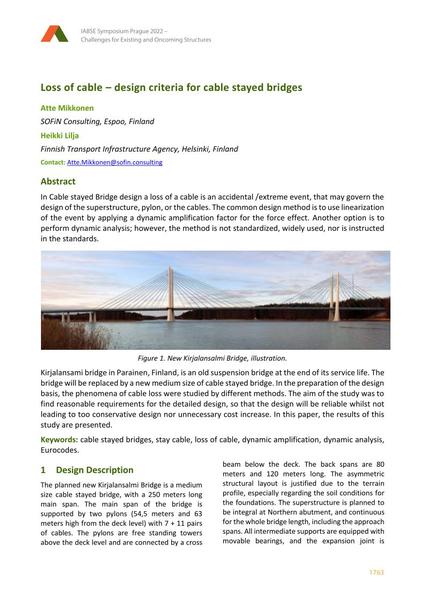Loss of cable – design criteria for cable stayed bridges

|
|
|||||||||||
Bibliographic Details
| Author(s): |
Atte Mikkonen
(SOFiN Consulting, Espoo, Finland)
Heikki Lilja (Finnish Transport Infrastructure Agency, Helsinki, Finland) |
||||
|---|---|---|---|---|---|
| Medium: | conference paper | ||||
| Language(s): | English | ||||
| Conference: | IABSE Symposium: Challenges for Existing and Oncoming Structures, Prague, Czech Republic, 25-27 May 2022 | ||||
| Published in: | IABSE Symposium Prague 2022 | ||||
|
|||||
| Page(s): | 1763-1771 | ||||
| Total no. of pages: | 9 | ||||
| DOI: | 10.2749/prague.2022.1763 | ||||
| Abstract: |
In Cable stayed Bridge design a loss of a cable is an accidental /extreme event, that may govern the design of the superstructure, pylon, or the cables. The common design method is to use linearization of the event by applying a dynamic amplification factor for the force effect. Another option is to perform dynamic analysis; however, the method is not standardized, widely used, nor is instructed in the standards. Figure 1. New Kirjalansalmi Bridge, illustration. Kirjalansami bridge in Parainen, Finland, is an old suspension bridge at the end of its service life. The bridge will be replaced by a new medium size of cable stayed bridge. In the preparation of the design basis, the phenomena of cable loss were studied by different methods. The aim of the study was to find reasonable requirements for the detailed design, so that the design will be reliable whilst not leading to too conservative design nor unnecessary cost increase. In this paper, the results of this study are presented. |
||||
| Keywords: |
stay cable dynamic analysis loss of cable Eurocodes Cable stayed bridges Dynamic amplification
|
||||
| Copyright: | © 2022 International Association for Bridge and Structural Engineering (IABSE) | ||||
| License: | This creative work is copyrighted material and may not be used without explicit approval by the author and/or copyright owner. |
||||

